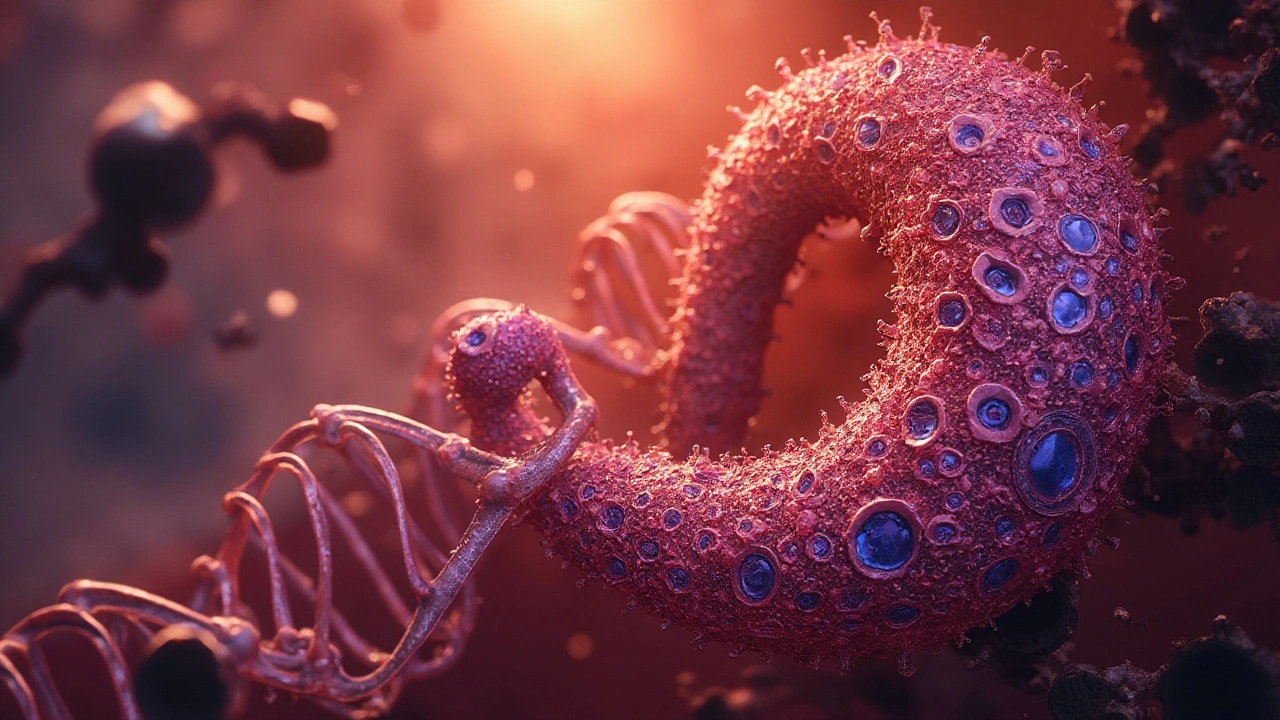While tremendous advancements have been made in the field of oncology, some forms of cancer still puzzle researchers and practitioners alike. Among these, pancreatic cancer stands out as particularly daunting. Many ask why, despite all our knowledge and technology, some cancers remain stubbornly difficult to tackle.
Pancreatic cancer is often dubbed as one of the hardest cancers to cure. The difficulty lies not just in its treatment but also in its timely detection. With symptoms that are vague and often show up only in advanced stages, patients rarely receive an early diagnosis, making the task of treatment much more arduous.
In the coming exploration, we will glimpse into the various reasons behind the hardened challenge posed by pancreatic cancer. From understanding its biological complexities to the promising areas of research paving the way for better treatments, we aim to shed light on this relentless opponent.
- Understanding Pancreatic Cancer
- Challenges in Early Detection
- Complexity in Treatment
- Hope for the Future
Understanding Pancreatic Cancer
Pancreatic cancer often takes the world by surprise, with its shadow looming large due to its aggressive nature and late detection timing. Most people do not realize they have developed this cancer until it has progressed to advanced stages, primarily because the pancreas is tucked away deep in the abdomen, making it hard to feel or notice changes. As a result, traditional screening methods are not always effective, and suspicious symptoms often resemble those of less serious illnesses, such as fatigue, abdominal pain, or weight loss. This complexity is one of the primary reasons why this form of cancer treatment often hits a dead-end, leaving patients and medical practitioners grappling for alternatives.
Interestingly, the biology of pancreatic cancer cells exacerbates its enigmatic nature. Unlike other cancers where tumors evolve at a relatively predictable pace, pancreatic tumors exhibit a genetic diversity, making them less susceptible to standard therapies. This diversity allows the cancer to effectively ‘hide’ from the immune system, developing resistance to chemotherapy and radiation treatments. This resilience calls for a creative approach among researchers, fostering innovative treatment methods that aim to outsmart the typical cancerous defenses. Unfortunately, the lack of early symptoms compounds the issue, meaning many patients are diagnosed when surgical options, a potential curative measure, are no longer viable.
For such reasons, the statistical outcomes for pancreatic cancer are often disheartening. The 5-year survival rate lingers in single digits worldwide, despite vigorous research and emerging treatment avenues. In a series of analyses conducted in 2022, up to 80% of pancreatic cancer cases were identified only after they had spread beyond the pancreas, severely limiting treatment possibilities.
As per the American Cancer Society, "Despite the incidence rates, pancreatic cancer receives only a fraction of the research funding compared to more common cancers, perpetuating a cycle of late-stage diagnosis and high mortality rates."This discrepancy underscores the urgent need for spotlighting the condition as a significant public health issue, enabling access to more research funds and public awareness.
In response, some regions have embarked on instituting comprehensive screening programs aimed at high-risk individuals to catch the disease before it establishes its stronghold. These strategies often involve endoscopic ultrasounds and MRI scans when signs of cancer are suspected in genetically predisposed individuals or those with family histories. Ultimately, the key to turning the tide with pancreatic cancer may well lie in blending innovations in biotechnology, increased awareness, and global collaborative efforts in research.

Challenges in Early Detection
Detecting pancreatic cancer early is notoriously difficult for medical practitioners. One of the primary reasons for this is the subtlety of early symptoms, which often resemble those of more benign conditions like gastrointestinal issues or back pain. Because these symptoms are seldom distinctive initially, they are frequently overlooked or misdiagnosed, allowing the pancreatic cancer to progress unchecked. People might only experience generalized discomfort, which rarely prompts immediate medical intervention, reducing the chances of catching the disease at a stage when treatment is most effective.
The placement of the pancreas deep within the abdomen compounds these challenges. This makes the tumor hard to detect during routine physical examinations. Furthermore, the pancreas is in close proximity to several other vital organs, which means the symptoms often manifest only after substantial progression or metastasis. When the disease reaches this state, it substantially reduces the likelihood of effective intervention.
Adding to the difficulty is the current state of diagnostic technology. Blood tests specifically targeting pancreatic cancer markers are lacking, as are reliable imaging techniques that can identify tumors at an early stage. As a result, by the time pancreatic cancer is identified, it often presents itself at stage III or IV, where it has started spreading. A study in the Journal of Clinical Oncology noted this concern, emphasizing the urgent need for improved screening methodologies that can reliably detect pancreatic cancer in asymptomatic individuals before it advances.
"The greatest challenge in early detection is not lack of technology," Dr. Smith of the National Oncology Institute stated, "but the subtle nature of the disease coupled with our current understanding of its biological behavior."
Efforts are currently underway globally to address these challenges. Scientists are researching genetic markers and risk factors linked to pancreatic cancer, hoping to identify at-risk individuals sooner. There is also significant investment in developing state-of-the-art imaging technologies that might provide a clearer, more specific view of the pancreas, capable of recognizing anomalies long before symptoms arise. However, these innovations are still in developmental stages, requiring more time and resources to reach practical application.

Complexity in Treatment
Pancreatic cancer presents unique hurdles when it comes to treatment, making it notoriously difficult to manage. Unlike some other cancers, pancreatic cancer doesn't just stay put. It has a knack for spreading quickly, often reaching other organs before it can be adequately caught and treated. This aggressive nature complicates treatment strategies significantly, demanding a combination of therapies that often include surgery, radiation, and chemotherapy.
The pancreas is located deep inside the abdomen, surrounded by several major organs and blood vessels, which makes surgical intervention a complex affair. Resectable tumors are rare, with only a small percentage of patients eligible for surgery. For those who do undergo surgery, the procedure is intricate, requiring a skilled hand to navigate the vital structures surrounding the tumor. The procedure, known as the Whipple procedure, is perhaps one of the most complex in surgery due to the extent of tissue and organ involvement. Once the tumor is surgically removed, recovery and careful monitoring are paramount, yet recurrence is an all too common reality.
Another factor adding to the complexity is the cancer's remarkable resistance to conventional treatments. Chemotherapy and radiation therapy, often the go-to for cancer treatment, are less effective against pancreatic cancer. This resistance arises from various factors, including the dense and fibrous tissue surrounding the tumors, which serves as a protective shield, and the genetic makeup of the cancer cells themselves, often harboring mutations that render common drugs ineffective. This has spurred the need for innovative research to find better ways to tackle this form of cancer.
"Pancreatic cancer's resilience is a testament to its ability to adapt and subvert our current treatment regimens," notes Dr. Jane MacDonald, an oncologist at Harvard Medical School. "We need to get smarter in our strategies, tailoring them to outsmart the cancer at each step."
The molecular complexity of pancreatic cancer is astounding. A slew of genetic mutations contributes to its formidable resistance. Notably, mutations in the KRAS gene, found in more than 90% of cases, play a pivotal role in the development and progression of the disease. This specific mutation fuels cell division and growth, helping the cancer grow and spread rapidly. Other genetic aberrations, such as those in the TP53 and SMAD4 genes, complicate the treatment landscape, making personalized medicine an attractive arena for potential breakthroughs. Therapies that target these genetic mutations are being closely researched, with promising clinical trials underway.
In this landscape of challenges, remarkably, there are glimmers of hope. Advances in immunotherapy and precision medicine hold promise for improving treatment outcomes. Unlike traditional therapies, immunotherapy harnesses the body's immune system to recognize and fight the cancer cells. Although still in its nascent stages for pancreatic cancer, early studies show encouraging results in immune checkpoint inhibitors and personalized vaccines designed to target specific cancer antigens unique to an individual’s tumor. As more is understood about the genetic makeup and protein expressions involved in pancreatic cancer, the better equipped researchers and clinicians become in devising treatments that can truly make a difference.

Hope for the Future
Despite the daunting challenges posed by pancreatic cancer, researchers remain unyielding in their pursuit of a breakthrough. The beacon of hope shines brighter than ever, driven by continuous advancements in medical technology and a deeper understanding of cancer biology. One of the most promising areas in the fight against this formidable foe is personalized medicine. By analyzing the genetic makeup of a patient's tumor, doctors can tailor treatments to the individual's specific cancer profile, increasing the chances of a successful outcome.
Recent breakthroughs in immunotherapy have also shown great potential. Scientists are focusing on harnessing the body's own immune system to recognize and attack cancer cells. This approach is not without its challenges, but significant strides have been made, bringing us closer to effective treatments for pancreatic cancer. A novel technique involves using engineered T-cells, known as CAR T-cells, which are equipped to target specific proteins on the cancer cell surfaces, thus enhancing the body's natural defenses.
Another significant development is in the realm of early detection technology. According to a report from the American Cancer Society, “Innovations in imaging techniques and biomarkers are pivotal in catching pancreatic cancer at an earlier, more treatable stage.” This sentiment captures the essence of forward-thinking research, which aims to increase the window of opportunity for successful intervention.
Clinical trials play an indispensable role in these advancements. The global medical community is abuzz with new trials exploring combination therapies. These involve the use of multiple drugs that work synergistically to block pathways promoting cancer growth. Researchers are hopeful that such combinations may prove more effective than single-drug therapies by tackling the cancer on multiple fronts.
The development of cutting-edge technologies like CRISPR also brings tremendous promise. By enabling precise editing of the genome, scientists have been able to better study pancreatic cancer genes, potentially leading to significant breakthroughs in prevention and treatment. This area of research is rapidly evolving and keeping a close eye on its progress could unveil novel strategies in the coming years.
Collaborative efforts are vital to maintaining this momentum. The coalition of researchers, oncologists, and pharmaceutical companies working together across borders and disciplines enhances the pool of knowledge and resources aimed at overcoming pancreatic cancer. Public awareness and funding are equally important stones paving the pathway to discovering effective cancer treatments.

 Top Hospitals for Orthopedic Surgeries You Should Know About
Top Hospitals for Orthopedic Surgeries You Should Know About
 Herbal Supplements: What Are the 3 Main Supplements You Should Know?
Herbal Supplements: What Are the 3 Main Supplements You Should Know?
 Herbs That Harm Your Kidneys: What to Avoid for Better Kidney Health
Herbs That Harm Your Kidneys: What to Avoid for Better Kidney Health
 Boost Your Metabolism for Weight Loss After 60
Boost Your Metabolism for Weight Loss After 60
 Why Is Therapy So Expensive? Unpacking the Real Costs
Why Is Therapy So Expensive? Unpacking the Real Costs